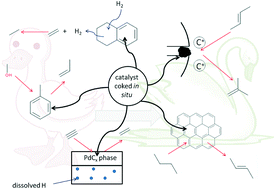Things go better with coke: the beneficial role of carbonaceous deposits in heterogeneous catalysis
Abstract
Carbonaceous or hydrocarbonaceous deposits formed on the surface of heterogeneous catalysts during reaction are typically associated with catalyst deactivation through coking. However, there are a number of cases where such deposits may enhance catalytic performance. This includes: coke deposits acting directly as the catalytically active site, e.g. in alkane dehyrogenation reactions; the selective deactivation of non-selective surface sites thereby increasing catalytic selectivity; and the participation of deposits in the reaction mechanism, including hydrogen and hydrocarbon transfer and the well-documented hydrocarbon pool in methanol-to-hydrocarbon conversion. The in situ formation of metal carbides also plays a key role in many reactions including alkyne hydrogenation and Fischer–Tropsch synthesis. These phenomena have been observed over all solid catalyst types including supported metals and metal oxides and zeolites. It is highly likely that there are many systems in which coke plays a positive role which have not yet been reported due to difficulties in deconvolving this from the role coke plays in deactivation. This review summarises the, at present disparate, literature in this important area and highlights how this understanding can be used to inform the rational design of catalysts and catalytic processes.

- This article is part of the themed collection: 2016 most accessed Catalysis Science and Technology articles


 Please wait while we load your content...
Please wait while we load your content...